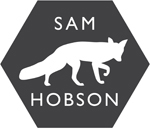Amateur Photographer Magazine (April 12th 2014) ran a story last week on my experiences photographing the urban fallow deer. I've added the unsubbed copy below..
"Always on the look out for interesting urban wildlife stories, my ears pricked up when I heard tales of wild fallow deer creeping out of the woods on dark Winter nights and heading into the city to feed. I’d just been shooting a few stories on birds of prey and badgers in urban environments, but deer on the streets of London?! I had to see this for myself. After asking around for a while, I got a tip-off on the location - well at least the rough area, but after studying a map to look for nearby woodland and chatting to a local bus driver, I had enough info to go on my first recce.
Unsure of how rough the area would be and how risky it would be to drive around by myself in the middle of the night with a load of expensive kit, I teamed up with fellow wildlife photographer and AP contributor, Luke Massey. Both from the big city and unafraid of a little nocturnal adventure, we headed out into the night on the hunt for our first truly urban deer. Luke the driver and me the spotter, it wasn’t long before we got lucky with our first small group of fallow does and fawns hanging about in a little shady copse at the end of a residential street. Excited that we’d found them, even if they were too hidden to photograph, we decided to explore the area further to try and find a group that were perhaps a bit more out in the open. It wasn’t long before we struck gold and found a fully grown fallow buck, feeding on a patch of grass beside a bus stop at the side of a main road. We drove past as quietly as we could and got out of the car to see if we could approach him. We were downwind, which was good, but as we crept towards him, he quickly got spooked and trotted off down the middle of the road, between the parked cars. I had wrongly assumed that these deer, being comfortable in an urban environment, would be approachable and ok with people, perhaps like the deer in Richmond park. In fact, they were the polar opposite as flighty as if they were in the middle of Dartmoor.
After this and a few further encounters with other just as flighty fallow, I realised that even though these deer might be comfortable enough to be out on the city streets after dark, they were by no means habituated or confiding. So with just a few blurry images of the backend of a deer disappearing into the distance so far, I realised that getting the pictures I wanted was going to require a little more effort and perhaps a different approach.
After a further recce and a first attempt at a shoot to work out the best way of coping with the low light, I started to work out the routes that the deer were using to come out of the woods and into the city streets and learn their habits. I decided that a night here and there wasn’t going to cut it, so I bit the bullet and booked myself into a roadside travel tavern and went nocturnal for a week.
Every night at about midnight, I’d drive to the area and locate the main groups of deer, then I’d position myself where I thought they would move to next. I’d park up and angle my car so that I could rest my lens on a bean bag through the window. Using a car as a hide worked perfectly, as to them, I just looked like another parked car. Getting myself in position first allowed me to compose the shot I wanted, manually set the focus and white balance and do some test exposures to make sure that if and when they did appear, I was ready to capture the moment.
Anticipating their behaviour, rather than reacting to it, was definitely the way to go. Sometimes I’d wait for an hour or more for nothing, but increasingly, I’d get it right, and the deer would walk into frame and I started to get the images I wanted.
At first, my images were perhaps a little too grainy in the shadows, so I started to experiment with longer exposures so I could reduce my ISO value. My 70-200mm was always wide open at f2.8 to maximise the amount of light reaching the sensor and I found that shooting at around ISO 500-640, with exposures of 1-3 seconds was giving me the best results. The beauty of photographing deer is that they often stop stock-still to look and listen for danger - often the sound of the camera shutter would be enough to get their attention and they’d look in my direction for long enough for me to fire off a few frames, before they’d start to feed or move again, when they would be blurred by the long exposures. Once I had my technique down, it was just a matter of luck, but sometimes if you’re in the right place at the right time it can all come together like when a fully grown fallow buck walks out in front of your lens and stands in front of a bus stop!"
Kit:
Nikon D800, Nikon 70-200mm AFS f2.8 VRii
Wildlife Watching Supplies Large Double Bean Bag


























